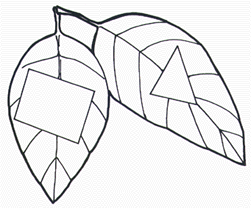 Materials:
Materials:
Of all the organisms in the natural world, green plants are the only ones that manufacture their own food. This process is called photosynthesis and begins when light strikes the plant's leaves (both sunlight and artificial light can power this process). Cells in the plant's leaves, called chloroplasts, contain a green pigment called chlorophyll which interacts with sunlight to split the water in the plant into its basic components.
Carbon dioxide enters the leaf through holes called stomata and combines with the stored energy in the chloroplasts through a chemical reaction to produce a simple sugar. The sugar is then transported through tubes in the leaf to the roots, stems and fruits of the plants. Some of the sugar is used immediately by the plant for energy; some is stored as starch; and some is built into a more complex substance, like plant tissue or cellulose.
Fortunately for us, plants often produce more food than they need, which they store in stems, roots, seeds or fruit. We can obtain this energy directly by eating the plant itself or its products, like carrots, rice or potatoes. Photosynthesis is the first step in the food chain which connects all living things. Every creature on earth depends to some degree on green plants.
The oxygen that is released by the process of photosynthesis is an essential exchange for all living things. Forests have been called the "lungs of the earth" because animals inhale oxygen and exhale carbon dioxide in the process of breathing, and plants take in carbon dioxide and give off oxygen in the process of photosynthesis.
But every year, over 28 million acres of tropical forest are cut and then burned to clear land for farming. Deforestation is also blamed for the "greenhouse effect" (global warming) which results from the build-up of carbon dioxide and other gases.
Chlorophyll--A green substance which gives leaves their color. Chlorophyll absorbs energy from sunlight which a plant uses to make food.
Chloroplast--A plastid that contains chlorophyll and is the site where photosynthesis and starch formation occur.
Photosynthesis--The formation of carbohydrates in the chlorophyll-containing tissues of plants exposed to light.
Stomata--A very small hole in the surface of a leaf. Oxygen and carbon dioxide from the air enter through the stomata; oxygen, carbon dioxide and water vapor leave through the stomata.
Discover what happens if you change the patterns of a plant's light source.
Main Activity
Without enough sunlight, plants cannot use the process of photosynthesis to produce food.
 Materials:
Materials:
1. Pick a shrub, tree or houseplant that you can use for an experiment.
2. Using the cardboard or aluminum foil, cut out some geometrical shapes like a circle, square or triangle. Make sure your shapes are big enough to make a patch that will cover nearly half of the plant leaf.
3. Paperclip each shape on a different leaf.
4. If you use a house plant, place it near a south, west or east window were it will get plenty of sunlight. Make notes about the weather each day and add them to your observations.
5. After four days, remove the shapes from the leaves and observe each of the leaves that had a shape covering it.
6. Compare the areas on the leaf that were covered with the shape to other parts of the leaf.
Questions
1. What has happened to the leaves? Describe the effects that the lack of sunshine has on leaves. What has or hasn't happened in the different parts of the leaf?
2. What is the best environment for a house plant? Why?
3. Where have you seen effects like these in nature?
4. Where would you expect to find fewer plants outside because of a lack of sunlight?
![]()
![]()
It is the year 2040 and you are a research scientist. The amount of sunlight
that reaches the earth has been reduced because of some major event like
pollution, volcanoes or global fires. Farmers are asking you for help to save
their failing crops. Figure out ways that you might help.
![]()
![]()
Design a way that you can make grass grow faster. Mark off two 10 cm x 10 cm
boxes of grass and vary the amount of light each square gets. How did light
affect the grass? What other changes could you make that would help grass grow
faster?
![]()
![]()
Take a trip to a local greenhouse to observe how they raise plants. Find out how
they use light, water or other elements to increase growth and productivity.
![]()
![]()
Discover if plants need soil for photosynthesis. Try growing a sweet potato just
in water. Put the bottom third of the potato in a glass or jar of water. If you
need help keeping the rest of the potato out of the water, you may want to
insert toothpicks in the potato so that they rest on the rim of the glass. Add
water every two to three days to keep the water level the same. Make sure the
potato receives a lot of light, and watch it closely. Do roots start to grow in
the water? Will the potato be able to sprout leaves or produce potatoes?